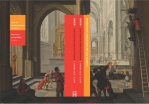

The Beeldenstorm and the Spanish Habsburg Response (1566-1570).
The Low Countries Historical Review - Bijdragen en Mededelingen betreffende de Geschiedenis der Nederlanden 131 (2016) 99-120
Abstract
In most textbooks, the punitive and military mission of the Duke of Alba to the Netherlands in 1567 embodies the Spanish Habsburg response to the Beeldenstorm of the previous year. This representation however, obscures the measures taken in the heat of the moment by Governor General Margaret of Parma, while it also downplays the numerous policy discussions to find the ‘right remedy’ for iconoclasm.
This article argues that repression formed but one part of a broader pacification strategy that also included mediation, reconciliation and reform. The tactic employed by the Spanish Habsburg authorities combined the punishment of prominent leaders with a recognition that most of the participants in the ‘troubles’ could neither be apprehended nor punished properly, so that a pardon would eventually be necessary. Just such a pardon was issued in July 1570.
Even if King and governor-general regarded iconoclasm as outright sacrilege and as divine lèse-majesté committed by heretics, the central authorities framed their response primarily as a legitimate action against worldly lèse-majesté and rebellion, in the short term to silence the religious violence of the iconoclasts, and in the longer term to maintain the initiative in safeguarding order, justice and peace, including in matters religious.
This article is part of the special issue 'Beeldenstorm'.
De Beeldenstorm en het Spaans-Habsburgse antwoord (1566-1570)
De strafmissie van de hertog van Alva in 1567 verschijnt in de meeste handboeken als het Spaans-Habsburgse antwoord op de Beeldenstorm. Deze voorstelling doet weinig recht aan de onmiddellijke maatregelen van de hertogin van Parma voor de komst van Alva, en nog minder aan de voortdurende zoektocht naar de ‘juiste remedie’ om de onrust te bedaren.
De repressie onder Alva vormde slechts een deel van een bredere pacificatiestrategie, die ook verzoeningsgebaren van koningswege inhield. Zo combineerde de Spaans-Habsburgse tactiek strafmaatregelen tegen de voornaamste leiders van de Beeldenstorm met de erkenning dat niet alle aanwezigen bij de ‘troebelen’ konden worden gearresteerd. Om rechtvaardigheid te doen geschieden, werd daarom in juli 1570 een generaal pardon uitgevaardigd.
Daarnaast beargumenteert deze bijdrage dat hoewel Filips II en zijn landvoogden in Brussel de Beeldenstorm als regelrechte blasfemie beschouwden, ze hun optreden hoofdzakelijk rechtvaardigden als een actie tegen rebellie en wereldlijke majesteitsschennis, om zo op de korte termijn de religieuze agenda van de opstandelingen te verzwijgen, en op de lange termijn het monopolie te behouden inzake ordehandhaving en godsdienst.
Dit artikel maakt deel uit van het themanummer 'Beeldenstorm'.